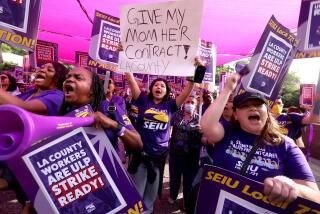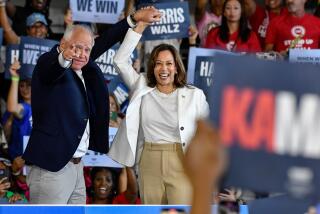Unions Warn They May ‘Take to the Streets’
America’s workers may soon have to “take to the streets” in massive demonstrations to stop the efforts of “powerful anti-labor forces” to destroy unions, several prominent labor and religious leaders warned their Labor Day audiences Monday.
Other union leaders and their allies scoffed at critics who have been predicting a dim future for organized labor. In speeches to Labor Day rallies here and in El Paso, AFL-CIO President Lane Kirkland predicted a “resurgence of labor’s strength . . . despite setbacks and enormous continuing problems.”
Unions Lose Strength
Unions have lost 2.7 million members since 1980, when President Reagan was elected, and now represent about 19% of the nation’s non-farm labor force, compared to about 33% in the mid-1950s.
Alan Kistler, national AFL-CIO director of organizing, told more than 700 guests at the 39th annual Catholic Labor Day breakfast here: “If they (anti-union forces) want war, then it is war they will get.”
Kistler said that it may be necessary for workers to “once again take to the streets” with marches, demonstrations and boycotts to defend unions and protect the rights of workers to organize.
Msgr. George G. Higgins, former executive of the National Council of Catholic Bishops and now professor of labor relations at Catholic University in Washington, told the breakfast audience: “Anti-union actions by many corporations and by the conservative (Reagan-appointed) majority on the National Labor Relations Board have seriously hampered the right of workers to organize and, to a degree which can no longer be tolerated, have nullified the basic purpose and objectives of the original (1935) National Labor Relations Act.”
Higgins, who was the recipient Monday of the Catholic Labor Institute’s Distinguished Service Award, said that workers may now be forced to “ignore the law and take to the streets” to preserve their rights. The remark received a standing ovation by union officers and members at the breakfast in the Hyatt Regency.
Among those attending were business and religious leaders and elected Democratic Party politicians, including Sen. Alan Cranston, Atty. Gen. John Van de Kamp and Los Angles Mayor Tom Bradley, who delivered a scathing attack on Republican Gov. George Deukmejian.
Bradley Urged to Run
Bradley only smiled, however, when William R. Robertson, executive secretary of the Los Angeles County AFL-CIO, urged the audience to help persuade the mayor to run again against Deukmejian in the 1986 gubernatorial election. That suggestion received an ovation from the audience.
Kirkland, speaking Monday afternoon to the Los Angeles County Federation of Labor picnic at the Valley Plaza, indicated that he believes unions may have to abandon, at least partly, the use of the national labor law, which was enacted during the Administration of President Franklin D. Roosevelt to encourage and help workers to form unions.
The NLRB, which administers the law, has been “packed (by Reagan) with radical conservatives who frustrate (union) organizing, discourage collective bargaining and delay and deny justice to workers,” Kirkland charged.
Also, with the help of the Administration, he said, “unfair employers who have never given up the dream of total control over the lives of workers have been reasserting their ‘right’ to rearrange wage levels and redefine working conditions as they alone see fit.”
Labor’s Obituary
Kirkland said that the obituary of organized labor “has been written at least once for every one of our 104 years of history, and at least that many causes of death have been diagnosed--gleefully or sorrowfully, depending on the diagnostician.”
But he said that a “new spirit of solidarity and confidence has been growing within our ranks” and that a “resurgent labor movement will lead the way” to frustrate the Reagan Administration’s dedication to “emasculating the federal government and to dividing the country, region against region, race against race and rich against poor.”
Other Labor Day picnics, rallies and marches were held in Southern California and across the nation.
At the largest celebration, in New York, more than 150,000 spectators watched an estimated 200,000 workers march, sing and dance up 5th Avenue and then heard New York Gov. Mario M. Cuomo, Mayor Edward I. Koch, City Council President Carol Bellamy and other speakers predict that the labor movement will soon enjoy a revival of strength.
It was the 103rd Labor Day parade in New York, giving that celebration a longer tradition than the national holiday itself, which was approved by Congress in 1894.
Parades in Other Cities
Parades were also sponsored by organized labor in Chicago, Pittsburgh, Milwaukee, New Haven, Conn., Grand Rapids, Mich., and other cities.
Those who used Labor Day to predict a resurgence of union strength generally said that the unions’ recovery will come about when they put into operation their own plans for development, ranging from new organizing techniques to major advertising campaigns to explain the values and traditions of organized labor and remind the nation of what life was like before unions were a significant force in this country.
New York Cardinal John J. O’Connor said: “Too many people in the U.S. do not realize what it was like before labor unions--the abominations that working people were subject to.”
More to Read
Get the L.A. Times Politics newsletter
Deeply reported insights into legislation, politics and policy from Sacramento, Washington and beyond. In your inbox three times per week.
You may occasionally receive promotional content from the Los Angeles Times.










